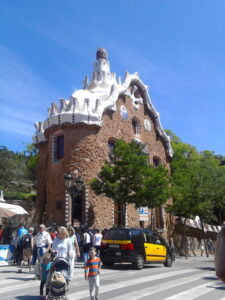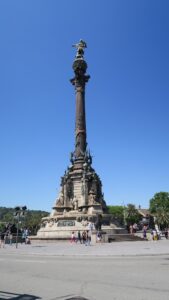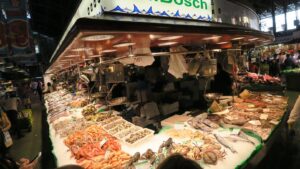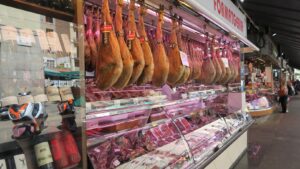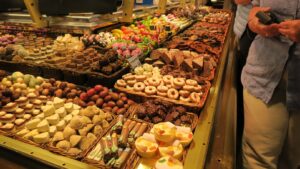News
Barcelona – the Jewel in the Crown of Catalonia
17 June 2016
On a recent family holiday to the Costa Dorada, we decided to have a day out in nearby Barcelona. Barcelona is the cosmopolitan capital of Spain’s Catalonia region, and is famed for quirky art and architecture, vibrant shopping markets and tasty tapas bars.
It is also home to the ever-evolving Sagrada Familia, which is still under construction, many years after the ambitious project was started by the Spanish architect Antoni Gaudi, way back in 1883. The unique and eye-catching building combines both gothic and curved Art Nouveau forms, and also incorporates religious and natural symbolism. Finished or not, the church is a UNESCO World Heritage Site, and is a huge draw to visitors. In fact, the iconic attraction is currently number 1 of an impressive 595 things to do in Barcelona. Read the many reviews on Trip Advisor.
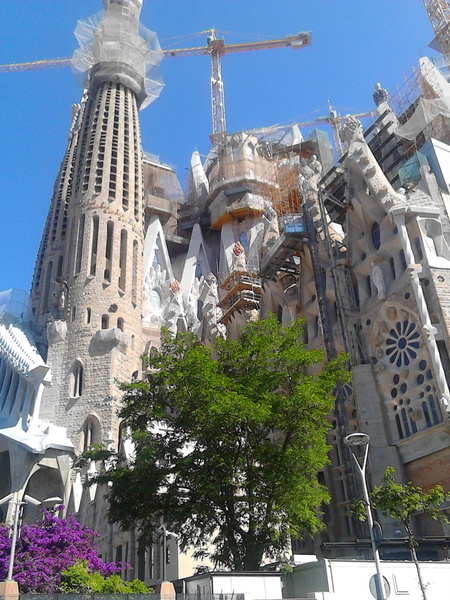
We didn’t go inside the interior of the building, but judging by the awestruck comments of those who had gone inside and witnessed the light streaming in through the stained-glass windows, and the intricate details of the building, it is well worth doing. Taking into account the huge queue to get in, when we visited, it is highly advisable to pay and book your timed entry slot in advance.
Although we didn’t linger long at the Sagrada Familia on this occasion, we did also visit another Gaudi-created attraction, which we thought would be more child-friendly and an oasis of greenery in the city – Park Guell.
For those who aren’t au-fait with Gaudi, and his lasting artistic legacy on the city of Barcelona, he was a Spanish architect whose work can be seen throughout the city, most notably in the Sagrada Familia, but also in Park Guell. He fused architecture, nature and religion in his works and included crafts such as ceramics, stained glass, wrought ironwork forging and carpentry. He worked organically and rarely drew detailed plans of his works, and tended to create them as three-dimensional scale models, moulding the details as he conceived them.
We had previously visited Park Guell on an earlier visit to Barcelona, and only had time to visit the section of the park that is free to visit, so this time we wanted to expand our visit to also include the Monumental Zone of the park, which you pay to enter. We booked our timed slot here, which is advisable due to the park’s popularity. The Park is also a UNESCO World heritage site, and is open all year round for both tourists and locals to enjoy.
It is worth noting that there is a steep walk uphill to get to the park, and also, that we didn’t see any refreshments available within the park, which may well be needed on a warm day after the ascent! There are several cafes and shops that stock snacks and drinks, on the way up, and there are plenty of picturesque spots with benches to sit and eat your picnic when you get up to the park. On closer inspection of the official website, there is a restaurant, but again, you may still prefer to take your own food and drinks. There is also a Park Guell shop within the park itself, but there are also ample souvenir outlets in the surrounding streets, to browse and buy from, if you fancy taking home a gift or memento.
Within the large free-to-roam areas of the park are a couple of small playgrounds for children and lovely greenery and gardens to meander through. Temptingly out-of-reach though, is the Monumental Area, which is home to the most impressive parts of Gaudi’s handiwork. It is worth paying the relatively small entrance fees to then have access to the whole park, which will probably take half a day to travel to, and enjoy in its entirety. It costs less to book online, than at the ticket offices, so this is another incentive to book online in advance. Children under the age of 6 can enter for free, children aged 7 – 12, those aged over 65, and the disabled and a carer, can enter for 4.90 Euros (£3.80) and a general ticket costs 7 Euros (£5.40). You can also book a guided tour service in different languages so you can learn first-hand about the history and meaning of the symbolism within the Park. Find out about booking a tour here.
We just made our own way round, following a recommended route, so we didn’t miss any of the stand-out features. The views alone from a multitude of viewpoints in the park, are well-worth the entrance fee, and the perspectives over Barcelona, framed by the many eyecatching buildings, sculptures and architectural features of the park create ideal vistas for family photo opportunities. Adults and children of all ages will marvel at the seemingly-impossible constructions, the myriad of colours and patterns, and the imaginative genius that conceived of the designs and artistic techniques that combined to create the whole fascinating ensemble. There are beautiful spots to sit and take in the wonderful panoramic views, meandering paths through lush greenery and tropical flowers, and spectacularly ornate fountains and focal points to enjoy at your leisure – there is no maximum amount of time that you can spend exploring the park.
We thoroughly enjoyed our time in the park, and it was a great antidote to the hustle, bustle and urbanity of the busy streets of Barcelona. We arrived at the park courtesy of the open-top tourist bus operated by Barcelona Bus Turistic. See the details and prices here. The hop-on and hop-off buses offer a great way of seeing the various landmarks and attractions that Barcelona has to offer, with the flexibility of alighting when you fancy, to visit somewhere that you want to spend more quality visiting-time. There is also the additional bonus of an audio tour being included, in several languages. You are given a set of complimentary earphones, which you take with you, which you plug in, and you are then provided with interesting facts and information about landmarks that you are passing. The kids loved being “plugged in” and picked up several facts on the way round, which they loved quizzing me on afterwards! There are three routes that you can opt for, within the same price, and they take in such iconic sights such as the Olympic Park on Montjuic Mountain (a reminder of the city hosting the event in 1992), the bustling port, which is now the main European port of call for holiday cruise ships, with over 3 million passengers every year, and also the must-see Sagrada Familia. The bus also passes by (and stops) at the Nou Camp, home to Barcelona’s all-conquering footballing super-team.
One drawback that we found was that we had to walk quite a way to find a bus stop, where we could get on the bus, from the particualr train station where we had got off. Although there are 31 bus-stops situated throughout the city, one eluded us for quite a while. The frustrating thing was that we kept seeing the distinctive buses passing us by, but they didn’t stop! Eventually, we spotted the Sagrada Familia and were able to get on to one of the buses at the stop there.
Another stress-factor on a very warm day, was the fact that the buses were so popular, and very busy. We ended up having to get on and sit on the bottom deck to start with, before then nipping up to the top-deck when we spotted other passengers coming down to get off. Sitting on the top-deck is obviously preferable, in order to get a better view of landmarks as you pass by, and also, to access a bit of fresh air to cool down a bit.
As mentioned previously, Barcelona is also known as being a mecca for foodies who appreciate the local seafood, tapas and laidback outdoor cafe-culture. A good bet to try out some new tastes and soak up the creative culinary atmosphere, is one of the cosmopolitan food markets of the city.
The one we visited, was ‘La Boqueria’ Food Market, which is almost two thirds of the way up the famous Ramblas. It’s on the right-hand side if you walk down from Placa de Catalunya (it’s a 5-minute walk down). Get there early to see it in full-swing, and aim to eat an early-lunch if you want to sit down at one of the food stalls, before they get really busy. It is one of Europe’s largest and most famous food markets, where you can immerse yourself in a world of exciting sights, smells and tastes. We found the freshly-squeezed fruit juices that you can buy from lots of stalls, are delicious and also good value.
The seafood is very fresh, and is worth sampling if you can. You can also order a range of small ‘tapas’ type dishes, whilst some stalls have a big paella bubbling away. If you’re into authentic and fresh food experiences, this is recommended.
Barcelona: Pickpocket capital of the world…
Barcelona has obviously got an awful lot going for it, which is testified to by its growing popularity with tourists visiting the city. This same popularity has also unfortunately, led to Barcelona bee one of the key factors in the city being named the ‘Pickpocket Capital of the World’. Spain’s high unemployment levels, plenty of bulging tourist wallets and a lack of an effective penalty deterrent have led to this unenviable reputation. Of course, no-one wants to be a victim of this kind of crime, but equally, this is no reason to stop you from visiting Barcelona – whilst making sure you take sensible precautions.
Here are some top tips to make sure you don’t become a victim of this kind of crime, not just in Barcelona, but anywhere:
- Trust your instincts, and don’t worry about being rude or upsetting somebody by asking them to move away from you, refusing to ‘answer a survey’, take a ‘free’ flower that is being proffered to you – if in doubt, ignore it, calmly say ‘no’ – and move on. You can take a look in more detail about the kind of tactics that pickpockets and petty thieves employ, here in our guide to common travel scams.
- Don’t take unnecessary things with you on a day out. Definitely leave your passports (and any expensive jewellery) in a locked safe deposit box back at your hotel, and only take as much money as you will need for the day. If you’re eating in a cafe, then make sure that you keep your bag close to you, maybe on your lap, and don’t leave your wallet or mobile phone out on show on the table as easy pickings.
- Think about where you will put your valuables – a bag carried across your body is safer than having a long-strapped one hanging off your shoulder, a bum-bag is also quite easy to cut or remove.
I was lucky enough to be able to wear a special security top which left me feeling much more confident and relaxed about the day, and hanging on to our precious Euros and my phone.
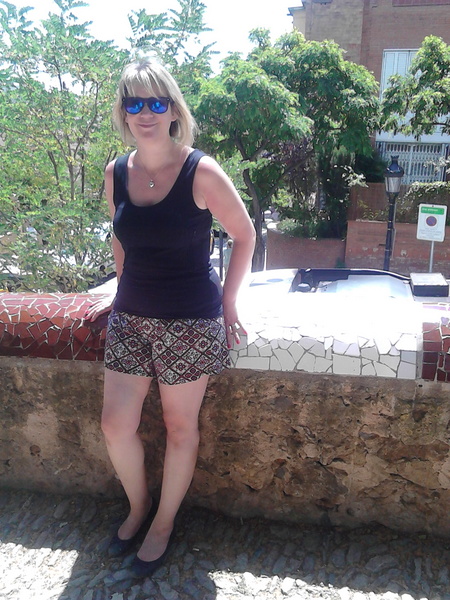
The top I wore was a Clever Travel Companion Travel Safety top , which is specially designed to give pickpockets a hard time in their attempts to relieve you of your valued possessions. From a style point of view, it is a very adaptable garment as it’s plain black – and can either be worn on its own or under another top – there are other styles and colours available. The straps are comfortably wide, the material of a good quality, and the fit was flattering and – unusually, as a taller person – long enough, for me.
The zipped security pockets were discreet and well-positioned, and could hold our train tickets, Euros and mobile phone comfortably. The pockets are positioned in such a way that it would be very hard for a pickpocket to position themselves to open them, without being extremely visible and obvious in their intentions! Of course, the proof is in the pudding – and I’m happy to report that all of our valuables remained safe about my person, despite the fact that I opened them several times to get money and tickets out -things stayed secure, yet accessible. One of these tops would be a great investment if you’re off on a backpacking adventure, or enjoy visiting large cities, where pickpockets are an endemic problem.
All in all, Barcelona is a definite must-visit for travellers of all ages and interests, there really is something for everyone.
* Please note that prices and other information were correct at the time the article was published, please do your own research before visiting.
Related posts
We’re all going on a working holiday!
12 July 2012Read more
Places to Visit | Travel NewsLondon is the most highly-rated city destination
30 July 2012Read more
Misc | Special EventsA Travel Insurance Policy for Father Christmas
3 December 2012Read more
CompetitionsHidden Gems Travel Competition Entries
7 March 2013Read more
